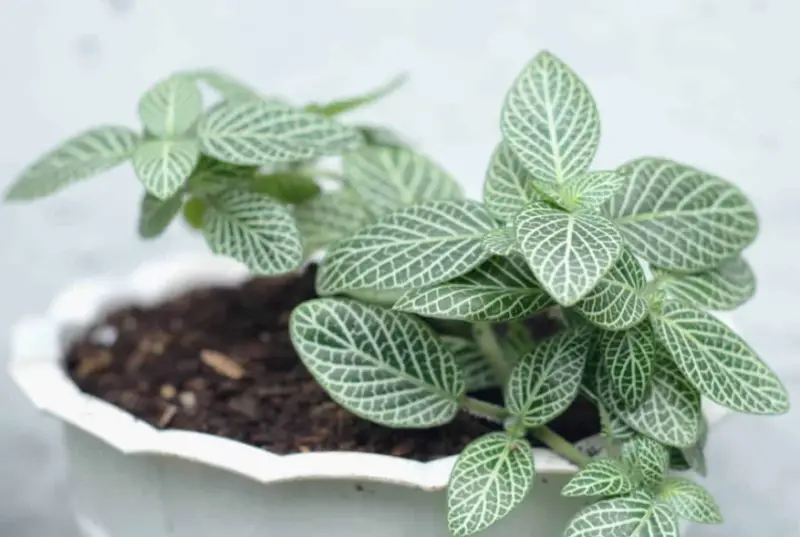The nerve plant (Fittonia albivenis), also known as the mosaic plant or painted net leaf, is a popular choice for houseplant enthusiasts due to its striking, veined leaves. With its intricate leaf patterns, the nerve plant brings a touch of tropical beauty to any indoor space. However, caring for this plant can be tricky, as it requires specific conditions to thrive.
This guide will provide everything you need to know about nerve plant care, including its optimal environment, propagation techniques, and how to troubleshoot common problems.
Overview of Nerve Plant

The nerve plant is an evergreen perennial native to the rainforests of South America, particularly in Peru and Colombia. Its deep-green, ovate leaves are delicately veined, most commonly in silvery-white. However, there are also varieties with veins in red, pink, or green, making the plant a vibrant addition to any space.
Although the nerve plant typically grows to a height of 3–6 inches with a trailing spread of up to 18 inches, its low growth habit makes it a perfect fit for terrariums, small planters, or as a creeping ground cover in warmer climates.
Key Information:
- Botanical Name: Fittonia albivenis
- Common Names: Nerve plant, mosaic plant, painted net leaf
- Family: Acanthaceae
- Plant Type: Perennial
- Mature Size: 3–6 inches tall, 12–18 inches spread
- Sun Exposure: Partial, indirect light
- Soil Type: Moist but well-drained, slightly acidic
- Hardiness Zone: USDA zone 11 (tropical climates)
- Native Area: South America
Growing Nerve Plant Indoors
Growing nerve plants indoors requires attention to detail, as they are sensitive to their environment. They thrive in high humidity and indirect light, making them ideal for terrariums or humid environments such as bathrooms.
Light Requirements
Nerve plants naturally grow in the humid, shaded forests of the tropics, so they dislike direct sunlight, which can scorch their leaves. Place your nerve plant in a spot that gets bright, indirect sunlight, such as near a north-facing window. Alternatively, you can grow them under fluorescent lights, which is especially useful in areas with low natural light.
If the light is too low, the plant’s vibrant vein colors may fade. A balance of indirect sunlight and shade is ideal for keeping the nerve plant healthy and vibrant.
Soil Conditions
Nerve plants prefer moist, well-drained soil that is rich in organic matter. A peat-based commercial potting mix works well, as it retains moisture while allowing for proper drainage. The plant also prefers a slightly acidic soil with a pH ranging from 6.0 to 6.5.
Ensure that your pot has adequate drainage holes to prevent the soil from becoming waterlogged, as overwatering can lead to root rot and other issues.
Watering and Humidity
Maintaining the right moisture level is critical for nerve plants. They are prone to wilting if they dry out, but they quickly recover when properly watered. However, frequent drying out and rehydrating can stress the plant, leading to long-term damage.
Keep the soil consistently moist but not soggy. It’s a good idea to check the soil’s moisture level regularly, and using a moisture meter can help ensure that you’re not underwatering or overwatering the plant. Additionally, maintain high humidity (above 60%) to mimic the plant’s tropical environment. A humidifier, regular misting, or placing the pot on a tray of pebbles and water are effective methods to increase humidity levels.
Temperature
Nerve plants thrive in temperatures between 60°F and 80°F (15°C to 27°C). Avoid exposing them to cold drafts or temperatures below 55°F (13°C), as this can cause leaf drop and slow growth.
Fertilization
During the growing season (spring and summer), apply a balanced liquid fertilizer diluted to half strength every 2–4 weeks. A fertilizer with an equal ratio of nitrogen, phosphorus, and potassium (such as 5-5-5) works well. Over-fertilizing can burn the roots and lead to yellowing leaves, so always follow the recommended dosage.
Common Nerve Plant Varieties
There are several popular varieties of nerve plants, each with unique leaf patterns and colors:
- Fittonia albivenis ‘Argyroneura’: Known for its striking white veins on deep green leaves.
- Fittonia albivenis ‘Verschaffeltii’: Features red or pink veins on darker foliage.
- Fittonia albivenis ‘Frankie’: A hybrid variety with light pink leaves and dark brown edges.
- Fittonia albivenis ‘Pearcei’: Showcases deep green leaves with red fishnet veins.
- Fittonia albivenis ‘Minima’: A low-growing variety ideal for terrariums, with small, delicate leaves.
- Fittonia albivenis ‘Red Star’: Stands out with deep red, oval leaves and frilled margins.
Propagation Techniques
Nerve plants can be easily propagated through stem cuttings, which is a preferred method for creating new plants. Here’s a step-by-step guide to propagate your nerve plant:
- Take Cuttings: In late spring or early summer, use sharp, clean scissors or garden shears to cut a stem that has at least two growing nodes.
- Prepare the Soil: Fill a small pot with a peat-based potting mix.
- Plant the Cutting: Insert the cutting into the soil, ensuring the bottom node is buried. Keep the soil moist but not soggy.
- Optional Rooting Hormone: If conditions are less than ideal, you can dip the cuttings in rooting hormone to increase the chances of successful propagation.
- Wait for Roots: Within 2–3 weeks, the cutting should develop roots, at which point you can repot the new plant.
Potting and Repotting
Nerve plants can be grown in any standard pot with good drainage. Repotting should be done once a year in spring or early summer, using fresh potting soil to prevent soil compaction and waterlogging.
Steps for Repotting:
- Choose a new pot that is slightly larger than the current one.
- Carefully remove the plant, gently loosening the roots.
- Place the plant in the new pot, fill it with fresh soil, and water thoroughly.
Troubleshooting Common Nerve Plant Problems
Despite its beauty, the nerve plant can be finicky. Here are some common problems and their solutions:
Leaves Turning Yellow
Yellow leaves are usually a sign of overwatering. Ensure the soil is moist but not waterlogged, and always use pots with drainage holes to prevent water from accumulating.
Leaf Drop
If your plant is experiencing leaf drop, it may be due to exposure to cold drafts or low temperatures. Try moving the plant to a warmer, more stable environment.
Dry, Shriveled Leaves
This typically indicates a lack of humidity or too much direct sunlight. Increase the humidity using a humidifier or by misting the plant regularly, and keep it out of direct sunlight.
Pest Issues
Nerve plants are occasionally plagued by pests such as mealybugs and aphids. Use an insecticidal soap or neem oil to treat infestations and isolate affected plants to prevent the spread of pests.
Nerve Plants in Terrariums
Nerve plants are ideal for terrariums due to their preference for high humidity and low light conditions. They pair well with other tropical plants like ferns, polka dot plants, and creeping fig, creating a lush, miniature ecosystem.
Conclusion
Although the nerve plant requires some attention, its striking appearance makes it well worth the effort. By providing the right balance of light, humidity, and water, you can keep this tropical beauty healthy and thriving for years to come. Whether grown as a houseplant, a terrarium centerpiece, or a ground cover in warmer climates, the nerve plant is a unique addition to any plant collection.






